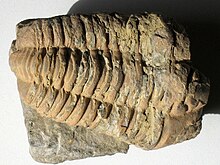Paleontology/Introduction
Introduction to Palaeontology
In this lesson we will focus on the field of palaeontology, how it evolved and what is covoured in the study. Over all the lesson is divided into sections.
- What fossils are
- Development and people who have influenced palaeontological theory.
- Geological structures of fossiliferrous bearing material.
- Timescale of evolution.
- References
1.What fossils are
Basic types of fossils
[edit | edit source]In essence, a fossil is evidence of an organism's existence preserved in rock and soil, and some, like w:Brachiopods, w:Radiolarians make up the rock by being compacted together, as in the case of w:limestone. The most common type of fossil are either casts of the organism or permineralized fossils. Permineralization is a fossil in which the bone or exoskeleton is replaced by another mineral.
Other types of fossils are the chemical fossils or w:biomarkers, where evidence of life is found through organically made chemicals. Famous chemical fossils are the w:iron ore deposits of the w:Hamersley Range in Australia, which is the process of oxidation of iron in the environment built up using excess oxygen from cellular respiration. w:Trace fossils are rare, but good specimens are known, they are preserved nests, burrows, excrement, tracks, etc., that tell us how a species lived when alive. What is a fossil from Ukonline

Readings
[edit | edit source]- Types of Fossils from Teachers Domain.com
- Fossils - Remains of Ancient Plants And Animals, Evidence of Life by Steven Dutch from the University of Wisconsin.
- Fossils: Window to the past from Berkeley University.
How fossilization happens
[edit | edit source]The occurance of fossils, whilst might seem common as they are very distinctive, in essence are a rare event. Most organic matter is broken down quickly in any habitat and for the specimen to survive, burial needs to happen. Even after the specimen is buried the chance of it surviving depends on various factors, like the type of burial, chemical make up of the soil, type of species, w:anatomy, climate and other environmental forces. For optimal preservation to happen a quick burial and compaction of the soil needs to happen. This can minimalize the destruction of the specimen by other species of life and nature. The best preserver is in fact salt water as the salts and other minerals would impregnate and start to replace the original material of the fossil.
The type of sediment preservation that takes place determines how well the fossil is preserved. For example specimen 1 was possibly found in mud shale. The specimen shows fine detail as the sediment itself is fine grained. Wheras specimen 2 shows only the basic detail of the specimen in the slightly coarse matrix, w:crystals can be seen as little specs on the specimen.

Readings
[edit | edit source]Age to be a fossil
[edit | edit source]As to the age of a fossil specimen, there is no minimum age for any specimen to be classed as a fossil. The modern w:Tasmanian tiger, w:Elephant etc have fossil evidence of living species, even Homo sapien sapiens (you and I) can be fossils after we die. Neither does the fossil have to be rock, w:organic matter of a young age can be classed as fossils with the original organic material. As in the case of w:permafrost w:Mammoths from Siberia that have been found frozen in the tundra with bone, skin, hair etc, from as long ago as 10,000 years.
Some fossils are derived fossil, meaning that the fossil is older than the strata it is associated with. This happens when the fossil is eroded out of its natural casing and deposited into new sediment which forms new rock. Such fossils age are hard to determin, but by analysing similar fossils of dated species an age could be calculated. For some species an age can not be determined.
Readings
[edit | edit source]Fossil record
[edit | edit source]The w:fossil record is like any other record, it describes the path of the development of life through time from 4,600 million (Geological time scale from the University of Kentucky) years ago to the current era. During earlier time periods species were evolving and up till 610 million years ago were w:single celled organisms with w:multicellular specimens appearing in abundance and showing signs of their evoluton going back to a longer perion in the w:Ediacaran biota. These specimen's are barely or not at all recognisable with current species of life wich was evident in the w:Cambrian explosion(Phillip's 2003 p.37). All this is recorded within specific kingdoms, Families, Phyla, Genera, to Species and subspecies and it connect's the relationship of all species together. But this record is incomplete as a lot of species leave no trace, or if they did the fossils have been destroyed or not found yet.
There are several forms of dating fossil or rock w:stratum:
1. w:Relative dating is based on the Principal of w:Original horizontality, Lateral Continuity, Superposition and Faunal Succession and is described as the theory that layers of sedimentary rock are layed in the order of older at the bottom to younger at the top. And the occurance of a species who live for short periods of time and can unit different strata localities into a specific time period.
2.w:Absolute dating, by using radiation via w:isotopes to analyse w:radioactive decay. This is good to analyse recently fossilised organisms via C-14. For longer periods the sediment itself must be analysed, this would give a date for the original material, like an ignious rock formation that is eroded but not the present sedimentary rock.
3.w:Paleomagnetics study of magnetism in rock strata to indicate the magnetic poles position andor continental rotation.
4.w:Geologic time all the above put into correlating data.
ReferencesDating methods from the Smithsonian Institute Eusphenopteris neuropteroides
Readings
[edit | edit source]- The fossil record by the Virtual Fossil Record
- Examining the Fossil Record by Shannan Muskopf
- Taxonomy, Transitional Forms, and the Fossil Record by Keith B. Miller of the Kansas State University, Manhattan
